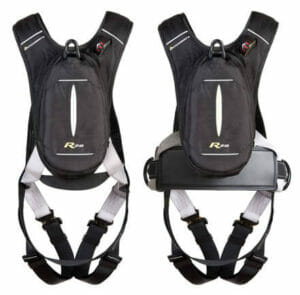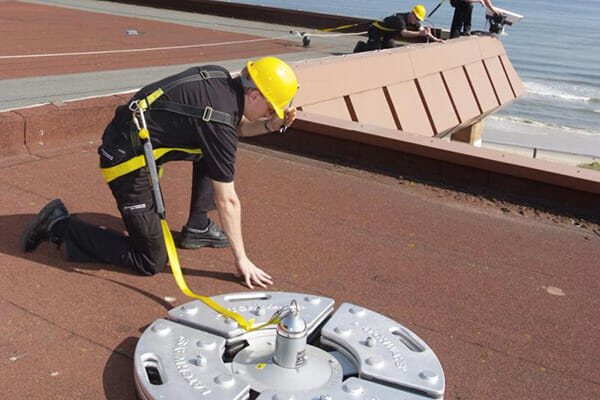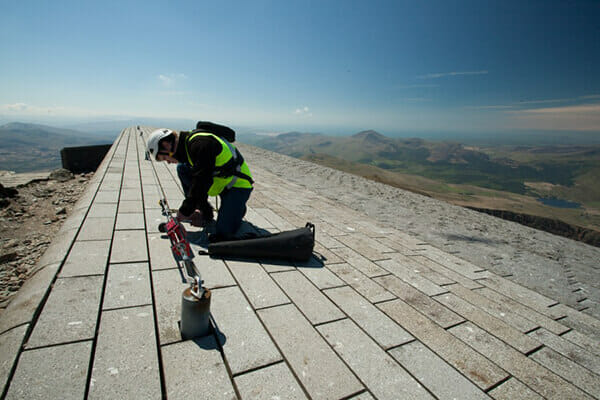The Dangers of Suspension Trauma
Dr Dave Merchant, Technical Standards Manager at TAG explains the dangers of suspension trauma and how standard first-aid techniques can sometimes kill instead of cure.
Suspension trauma, also known as orthostatic intolerance or harness hang syndrome, can be a killer. Although its effects have been known about for decades it is only recently that industry regulators, rescue teams and all those who wear harnesses as part of their work, have started to take notice.
The driving forces were the arrival of the Work at Height Regulations (WAHR) 2005 and British Standard BS 8473. The Regulations make it a legal duty for risk assessments and working practices to consider the risk of suspension trauma whenever personal fall-protection equipment is used. It is no longer acceptable to have written in your method statement to ‘call the fire brigade’
The WAHR require all users of personal fall-protection systems (from lanyards to rope access) to be trained in rescue and to plan work with the consequences of a fall in mind. This means they need to know how and when suspension trauma can happen, what to do to prevent it and how to treat it. Normal first-aid rules could effectively kill a sufferer.
Suspension trauma is simply fainting in a harness. It will happen to anyone who is held in an upright position and with their legs immobile. You don’t need to be ill, injured, or even in a harness to suffer the condition and if you don’t stop its progress, then you will lose consciousness and eventually die.
Harness hang
The initial symptoms of trauma (such as anxiety and a raised heart rate) occur in as little as five minutes. An otherwise-healthy person can lose consciousness within 10 minutes and then will be imminently at risk of death. Age, sex, weight and fitness make little difference to the risk.
Harness design has little bearing on preventing suspension trauma. To protect the spine, all fall-arrest harnesses are designed to hold the body upright no matter how it falls. A high-price padded harness will not prevent trauma, though it will make the first minutes a bit more comfortable. What matters is how to get out of this life-threatening situation.
It may be worth you checking out our personal rescue device harness right now PRD
Anyone working in a harness can prevent suspension trauma by using their leg muscles to keep the blood pumping back into the torso. The problem is that keeping your leg muscles moving enough is quite hard work and, if you are unconscious or injured, then you may not be able to move them at all.
If you are in a sitting position, you are unlikely to suffer suspension trauma. With your thighs horizontal, the height difference between your heart and legs is lessened and the pooling effect of blood in the legs is reduced to a safe level.
Hanging in a harness does not put you in a sitting position, but you can get into one if you can raise your knees far enough. If you are in mid-air then you need to make yourself a knee-loop to lift your legs, either from spare rope, hose, tape, clothing, or by carrying a dedicated emergency kit. Your priority as the person who has fallen, or as the person helping them, is to raise the knees as soon as possible. Even a 30-minute delay could be too long – the victim will probably be dead.
Fall-arrest harnesses normally have two attachment points – an upper front point and an upper back point. These are both designed to hold the body upright after a fall. Rear attachment points are often preferred as they keep all the lanyards out of the way when working. However, when you take into account suspension trauma, they are potentially lethal. Front points add clutter, but are much safer as they make knee-raising or assisting in a rescue much easier. TAG advocates that anyone at risk of being suspended after a fall should only use a front attachment point.
The way a sufferer of suspension trauma is rescued is critical. Lying them down can kill them instantly. As discussed, the condition occurs when the blood pools in the legs, reducing the oxygen supply to the brain. But there is also the matter of the blood pooled in the legs, which is trapped down there and prevented from collecting oxygen from the lungs or cleaning out toxins. The leg muscles use up all of the oxygen in the blood, then start to burn fats. The blood in the legs becomes stale, full of carbon dioxide, toxic chemicals and lacking any oxygen. So long as it stays in the legs, this stale blood is not an immediate risk.
But during rescue, it’s common for a casualty to be laid on the ground. When this happens, all the stale blood rushes back into the rest of the body in one huge slug. It can damage the organs as it passes through – most importantly the heart and kidneys. If a suspension trauma victim lies down, even for 20 seconds, they can die instantly of a heart attack or suffer multiple organ failure.
The solution is to lower them into a sitting position and keep them in that position for at least 30 minutes, so the stale blood is only released very gradually. This is contrary to standard first-aid training, which says you should lie someone down when they have fainted and raise their legs. Anyone helping rescue the casualty must stop medical staff doing this at all costs, and explain why.
Anyone who has been suspended for more than 10 or 15 minutes will have dangerously high levels of stale blood in their legs and, even if their heart survives the rescue, other organs can be damaged. As a result, anyone you suspect has suffered from suspension trauma must be sent to hospital for a check-up, even if they feel fine.
Spread the word
Everyone working at height must be educated about suspension trauma; at very least they should know the basic points in the box below. These could form the basis of a guidance card to be carried by all workers working in harness, partly to inform those treating and rescuing them and partly to help them persuade ambulance staff to follow the correct course.
The potential for suspension trauma must be considered in risk assessing operations at height. In some cases, it can be ruled out straight away (for example, where workers are climbing hooped ladders and working in pairs, they can always be reached and rescued by their workmates in a matter of seconds). In others, it may change your entire work plan.
The critical factor is decided by one question: can a worker become suspended in a harness for more than a few minutes? If the answer is yes, they are at risk from suspension trauma. TAG suggests that, for the purposes of a risk assessment, you must satisfy this simple rule: any worker must be rescued or repositioned to raise their knees within 10 minutes of falling. If you cannot meet the rule, find another way to do the job. In a true sitting position, patients can last over an hour. Your rescue plan should therefore work towards recovery-to-ground as soon as possible, but the first priority is raising the knees. You have to do that inside the 10-minute window.
The WAHR make it clear that you cannot rely on the emergency services as your sole rescue option. Call-out times can be a lot longer than 10 minutes, so you must have an internal rescue plan on site. The Regulations require that the plan includes physical rescue of the fallen climber from suspension.
Another aspect of risk assessment is the attachment point of the harness. As we have said already, use of rear attachment points makes repositioning and airway protection almost impossible, so you would be wise to require people to clip to the front. Climbers must not operate without another worker on site who is capable of reaching them and operating the rescue equipment, ideally within 10 minutes of the fall. TAG suggests all climbers carry mobile phones or mobile radios and knee-loops and that rescue kit is stationed near them.
In situations where two-man access would be impossible (for example due to weak structures) then some automatic self-descent system may need to be used. So a fallen climber is automatically lowered to ground after a fall.
The international guidelines on suspension trauma are available at www.suspensiontrauma.info
Suspension trauma basics
- Hanging in a harness with your legs still is an immediate risk to life.
- You must do everything possible within 10 minutes to rescue anyone who has fallen and is hanging in a harness.
- Raise the casualty’s knees into a sitting position – even if you cannot rescue them.
- Call for urgent help, even if they are not injured.
- During rescue, never allow them to lie on the ground.
- Keep them sitting up for 30 minutes after rescue, and force ambulance staff to follow these instructions.
- Send anyone who you think has suffered suspension trauma to hospital.
How suspension trauma happens
Our bodies are not ideally designed for being upright. Our hearts are quite high up in the body and can’t suck blood up from the legs, so whenever we are upright, gravity is pulling our blood down into our legs. The only thing that stops it staying there is a process of muscular pumping. The major veins in the legs are routed through the muscles, and so when we use those muscles, the blood is squeezed back up. This works well so long as we are using the muscles. Walking about is fine, but if we stand upright and keep still, the blood starts to pool in our legs.
The brain is the most demanding organ in terms of blood and oxygen supply. It cannot survive without oxygen, but when we are upright it’s in the worst position to get it – right at the top of the body. It does, however, have the ability to control its fuel supply, as pressure sensors (baroreceptors) in the head measure the blood pressure and can then change the heart rate and breathing to compensate. The problem is that the brain can’t tell the difference between blood pooling in the legs and blood loss from bleeding. The way it reacts is the same, and this can make things a lot worse for someone in a harness.
The first thing that happens when blood starts to pool in the legs is that the brain increases pulse and breathing rates, thinking you are bleeding. You feel hot, sweaty, dizzy, breathless and anxious as oxygen and carbon dioxide levels change, but as well as pushing more blood to the brain you are also pushing more blood into the legs.
Your brain doesn’t know this, so doesn’t give you a strong desire to raise your knees, which would be a much better response. With blood continuing to collect in your legs, eventually the brain realises that its supply is still dropping. It kicks in the emergency last-resort plan (called the Central Ischemic Response) which is to make you fall over, so it is no longer at the top. To fall over, your brain makes you faint. It can’t just “turn off” so it has to throw away its last oxygen reserves by dropping your pulse rate really low, and that makes you pass out. You fall over and all the blood sorts itself out, problem solved.
The problem is that you cannot fall over in a harness. So, you are unconscious, upright and now have low pulse and breathing rates. You are now at imminent risk of death, for two reasons. First, your airway is not safe in this position, so you can suffocate. Second, your brain now has next to no oxygen and no way to get any more.
Because you haven’t fallen over, your brain cannot wake you up again. The body has no “plan B”.
To advertise with Fall Arrest or for any other enquiries please contact us here
- Image below is the Personal Rescue Device (PRD)
- For further information on the personal rescue device, please visit our PRD section






